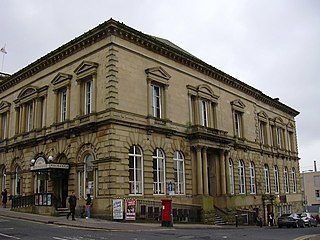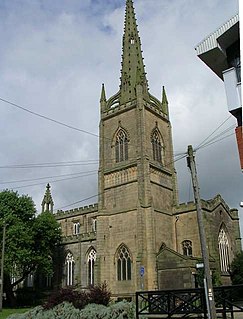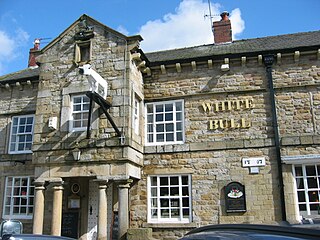The manor of Stydd is in the county of Lancashire. It is situated on the north eastern edge of the village of Ribchester. It has three notable buildings: St Saviour's Church, a set of almshouses and the Church of Saint Peter and Saint Paul.

Abbeystead House is a large country house to the east of the village of Abbeystead, Lancashire, England, some 12 km south-east of Lancaster. It is recorded in the National Heritage List for England as a designated Grade II listed building.

St Paul's Church is in Scotforth, a suburb of Lancaster, Lancashire, England. It is recorded in the National Heritage List for England as a designated Grade II listed building. It is an active Anglican parish church in the deanery of Lancaster, the archdeaconry of Lancaster and Morecambe, and the diocese of Blackburn. The architectural historian Nikolaus Pevsner described it as a "strange building" and "an anachronism, almost beyond belief".

St Wilfrid's Church is an Anglican church in the village of Ribchester in Lancashire, England that is situated close to the site of a Roman fort. It is an active parish church in the Diocese of Blackburn. It is recorded in the National Heritage List for England as a designated Grade I listed building.

St Saviour's Church is an Anglican chapel in Stydd, a hamlet near Ribchester in Lancashire, England. It has been designated a Grade I listed building by English Heritage.

The Burnley Mechanics is a theatre and former Mechanics' Institute in the market town of Burnley, Lancashire, England. It was built 1854–55 and converted to a theatre in 1979. Historic England has designated the theatre a Grade II* listed building.

St Peter's Church is a redundant Anglican parish church in St Peter's Square, Preston, Lancashire, England. It is recorded in the National Heritage List for England as a designated Grade II* listed building. It was a Commissioners' church, having received a grant towards its construction from the Church Building Commission. In 1973 it became part of Preston Polytechnic, later the University of Central Lancashire.

Lancashire is a county in North West England. In 1974 parts of the historic county were divided between Greater Manchester, Merseyside, Cheshire and Cumbria, and part of the West Riding of Yorkshire was transferred into the county, creating the non-metropolitan county of Lancashire. Together with the unitary authorities of Blackburn with Darwen and Blackpool it now forms the ceremonial county of Lancashire.
Dutton is a civil parish in Ribble Valley, Lancashire, England, located to the northeast of Ribchester. The parish is rural, with the River Ribble running to the south. It contains 15 buildings that are recorded in the National Heritage List for England as designated listed buildings. These mainly consist of houses with related structures, or farm buildings, but there are also a church, a bridge and two cross bases.

St Mary's Church is in St Mary's Street, Preston, Lancashire, England. It is a redundant Anglican parish church, and was converted into a conservation centre in 2006. The church is recorded in the National Heritage List for England as a designated Grade II listed building.

Arkwright House is in Stoneygate, Preston, Lancashire, England. The house was built in 1728, and was later expanded and restored. It is notable as the place in which Richard Arkwright and colleagues worked in 1768 to develop the water frame, a machine for spinning yarn. The house is an example of Georgian architecture, and is recorded in the National Heritage List for England as a designated Grade II* listed building.

Carey Baptist Church, is in Pole Street, Preston, Lancashire, England. It is recorded in the National Heritage List for England as a designated Grade II listed building.

St Joseph's Church is in Skeffington Road, Preston, Lancashire, England. It is an active Roman Catholic church in the Diocese of Lancaster. The church is recorded in the National Heritage List for England as a designated Grade II listed building.

City Mosque Preston is in North Road, Preston, Lancashire, England, and is recorded in the National Heritage List for England as a designated Grade II listed building.
Charnock Richard is a civil parish in the Borough of Chorley, Lancashire, England. The parish contains 12 buildings that are recorded in the National Heritage List for England as designated listed buildings. Of these, two are listed at Grade II*, the middle grade, and the others are at Grade II, the lowest grade. Apart from the village of Charnock Richard, the parish is rural. Most of the listed buildings are, or originated as, farmhouses and farm buildings. The other listed buildings consist of a church, a bridge, a school and schoolmaster's house, and almshouses with associated buildings.
Clayton-le-Dale is a civil parish in Ribble Valley, Lancashire, England. It contains five listed buildings that are recorded in the National Heritage List for England. Of these, one is at Grade II*, the middle grade, and the others are at Grade II, the lowest grade. The parish contains the village of Clayton-le-Dale and surrounding countryside. The listed buildings consist of houses, a former toll house, and a bridge.
Osbaldeston is a civil parish in Ribble Valley, Lancashire, England. It contains five listed buildings that are recorded in the National Heritage List for England. Of these, three are at Grade II*, the middle grade, and the other two are at Grade II, the lowest grade. The parish contains the village of Osbaldeston, and is otherwise rural. The listed buildings consist of two country houses, a barn, a church with attached presbytery, and a school.
Ribchester is a civil parish in Ribble Valley, Lancashire, England. It contains 23 listed buildings that are recorded in the National Heritage List for England. Of these, one is listed at Grade I, the highest of the three grades, one is at Grade II*, the middle grade, and the others are at Grade II, the lowest grade. The parish contains the village of Ribchester, and surrounding countryside. Most of the listed buildings are houses and associated structures, or farmhouses and farm buildings, some of which are in the village, and others are in the rural area. The other listed buildings are two churches, a presbytery, a sundial, a public house with a mounting block outside, a bridge, and almshouses with a wellhead in the grounds.

The White Bull is a public house and inn on Church Street in the English village of Ribchester, Lancashire. It dates to 1707 and is a Grade II listed building with some unique exterior features.

Ribchester Bridge is a toll-free, three-span bridge in Clayton-le-Dale, Lancashire, England. A Grade II listed structure, it spans the River Ribble, carrying the two-lane traffic of the B6245 Ribchester Road to or from Ribchester to the west.















